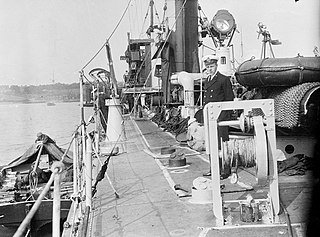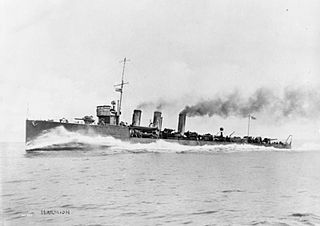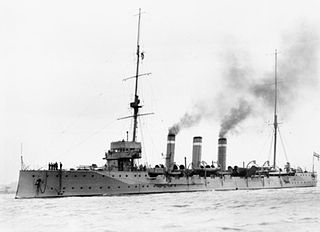
HMS Wolverine was a Beagle-class destroyer of the Royal Navy launched on 15 January 1910. She was built by Cammell Laird at Birkenhead.

HMS Laforey was the lead ship of her class of destroyer built for the Royal Navy. Launched a year before the First World War began, she was attached to the Dover Patrol. Laforey saw action in several engagements with German torpedo boats, including the Battle off Noordhinder Bank and the action of 17 March 1917. Laforey was sunk in 1917 by a British mine after escorting several freighters to France. She was named for Francis Laforey, captain of HMS Spartiate at the Battle of Trafalgar in 1805.

HMS Scorpion was one of sixteen Beagle-class destroyers in service with the Royal Navy in the First World War. She was built by Fairfields Govan shipyards on the Clyde and was commissioned on 30 August 1910. She was a coal powered ship and as such was obsolete by the end of the First World War and was scrapped in 1921.

HMS Pincher was a coal-fired Beagle-class destroyer of the Royal Navy built by William Denny and Brothers and launched on 15 March 1910.
HMS Beagle was one of sixteen destroyers ordered under the 1908–09 Naval Estimates from John Brown & Company of Clydebank. Named for the English hunting dog, she was the sixth ship to carry this name since it was introduced for a Cruizer Class fir-built, brig-sloop on 8 August 1804 and sold on 21 July 1814. The destroyers of the 1908–09 program would be the last coal-fired destroyers of the Royal Navy. She and her sisters served in the First Destroyer Flotilla then were moved en masse to the Third Destroyer Flotilla and before the start of the Great War to the Fifth Destroyer Flotilla. With the advent of the convoy system they were moved to the Second Destroyer Flotilla. With the Armistice she was laid up then scrapped in 1921.

HMS Matchless was a Royal Navy Admiralty M-class destroyer. Matchless was built by Swan Hunter from 1913 to 1914 and was completed in December that year. She served through the remainder of the First World War, operating in the North Sea as part of the Harwich Force in the early part of the war and later in the English Channel as part of the Dover Patrol, where she took part in both the First and Second Ostend Raids. Despite being badly damaged by a German mine in 1915 and being involved in several collisions, she survived the war, and was sold for scrap in 1921.

HMS Foxhound was a Beagle-class destroyer of the British Royal Navy. The Beagles were coal-fuelled ships, designed for a speed of 27 kn, armed with a 4-inch (102 mm gun and two torpedo tubes. Foxhound was built by John Brown & Company at their Clydebank yard, between 1909 and 1910, being launched on 11 December 1909 and completing in August 1910.
HMS Grasshopper was a Beagle-class destroyer of the British Royal Navy. The Beagles were coal-fuelled ships, designed for a speed of 27 kn, armed with a 4-inch (102 mm gun and two torpedo tubes. Grasshopper was built by Fairfield Shipbuilding & Engineering Company at their Govan yard, between 1909 and 1910, being launched on 23 November 1909 and completing in July 1910.

HMS Lawford was a Laforey-class destroyer of the British Royal Navy. The Laforey class was the class of destroyers ordered under the Royal Navy's 1912–1913 construction programme, which were armed with three 4-inch (102 mm) guns and four torpedo tubes and were capable of 29 knots. The ship, which was originally to be named Ivanhoe but was renamed before launch, was built by the Scottish shipbuilder Fairfields between 1912 and 1914.

HMS Nicator was an Admiralty M-class destroyer which served with the Royal Navy during the First World War. The M class was an improvement on the preceding L class, capable of higher speed. Launched in February 1916, the destroyer fought in the Battle of Jutland between May and June 1916, operating in support of the British battlecruisers in their action against the German High Seas Fleet. Nicator claimed, along with sister ship Nestor, the destruction of a German torpedo boat, likely to be V27. The destroyer also attacked the German battlecruisers and battleships and, although no hits were recorded, kept the German ships from closing with the British. This was crucial to limiting losses to the British battlecruiser fleet. The vessel was subsequently fitted with paravanes for anti-submarine warfare. After the war, the destroyer was placed in reserve and subsequently sold to be broken up in May 1921.

HMS Penn was a Repeat Admiralty M-class destroyer which served with the Royal Navy during the First World War. The M class were an improvement on the preceding L class, capable of higher speed. The ship was named after William Penn, the father of the founder of Pennsylvania. Launched on 8 April 1916, the vessel served with the Grand Fleet forming part of the screen for the dreadnought battleships of the 1st Battle Squadron and escorting the aircraft carrier Furious in battle. The destroyer participated in the Actions of 19 August 1916 and 16 October 1917, as well as forming part of the distant support during the Second Battle of Heligoland Bight. Penn was also instrumental in rescuing the survivors from the light cruiser Nottingham, sunk by a German submarine. After the Armistice that ended the war, the destroyer was placed in reserve and subsequently sold to be broken up on 9 May 1921.

HMS Moorsom was an Admiralty M-class destroyer which served in the Royal Navy during the First World War. The M class was an improvement on the preceding L class, capable of higher speed. Moorsom, the first ship to enter navy service to be named after Admiral Sir Robert Moorsom, was launched in December 1914, initially serving as part of the Grand Fleet before being transferred to the Harwich Force the following year. Briefly rejoining the Grand Fleet, the destroyer saw service in the Battle of Jutland in 1916 supporting the British battlecruisers and received hits from a battleship of the German High Seas Fleet. Moorsom also undertook other duties, including escorting the troop ship Mauretania in June 1915 and the minelayer Princess Margaret in August 1915 and November 1916. Placed within the Dover Patrol, the destroyer formed part of the cover for monitors including Erebus and Terror on attacks on Ostend and Zeebrugge in May and June 1917, and April and May 1918. After the Armistice, the destroyer was placed in reserve and subsequently sold to be broken up in November 1921.

HMS Mystic was an Admiralty M-class destroyer which served with the Royal Navy during the First World War. The M class was an improvement on the previous L class, capable of higher speed. The vessel, originally named HMS Myrtle but renamed before being launched in 1915, joined the Grand Fleet as part of the Eleventh Destroyer Flotilla. The ship was assigned as part of a destroyer screen to protect the British battleships as they sought to destroy the German High Seas Fleet. During the Battle of Jutland in 1916, the destroyer saw action against German light cruisers and, as the evening fell, attacked the German battle line, but recorded no hits. During the following year, the vessel took part in a large anti-submarine patrol, but did not see any German submarines. Later in the war, the ship was transferred to the Coast of Ireland Station at Buncrana and escorted convoys at the start of their journey from ports on the Clyde and Mersey or at the end of their journey across the Atlantic Ocean. After the Armistice in 1918 that marked the end of the First World War, Mystic was placed in reserve before being decommissioned and subsequently sold to be broken up in 1921.

HMS Morris was an Admiralty M-class destroyer which served with the Royal Navy during the First World War. The M class were an improvement on the preceding L class, capable of higher speed. The ship, the only vessel to be named Morris to serve with the Royal Navy, was launched on 19 November 1914. Joining the Grand Fleet as part of a new flotilla, the destroyer was soon in action, serving as part of a destroyer screen during the Battle of Dogger Bank in January 1915 and an escort to the minelayer Princess Margaret during a skirmish with German torpedo boats eight months later. At the Battle of Jutland in 1916, the destroyer was a crucial part of the flotilla that drove the German torpedo boats away from the British battlecruisers. Morris received no hits during these confrontations. The destroyer assisted in the rescue of survivors from the R-class destroyer Simoom and the recovery of the damaged flotilla leader Botha in 1917. The ship also undertook general duties including escorting merchant ships, minelayers, monitors, and the seaplane carrier Vindex. After the armistice that ended the war, the destroyer was considered superfluous to requirements, Initially placed in reserve, Morris was decommissioned and, on 8 November 1921, sold to be broken up.

HMS Marne was an Admiralty M-class destroyer which served with the Royal Navy during the First World War. The M class was an improvement on the preceding L class, capable of higher speed. The ship, the first Royal Navy vessel to be named after the River Marne, was launched in 1915. For much of the war, the destroyer escorted merchant ships in convoys and Royal Navy warships, but was also involved in the rescue of crew from the battleship HMS King Edward VII in 1916. The destroyer also took part in the Battle of Jutland as part of the shield for the British battleships and engaged with the German light cruiser force with torpedoes, although all missed. In 1918, the destroyer, along with sister ships Milbrook and Pigeon, sank the German submarine UB-124. After the armistice, Marne was placed in reserve before being decommissioned and, in 1921, sold to be broken up.

HMS Topaze was a Topaze-class protected or third-class cruiser which served in the Royal Navy during the First World War. The vessel was the lead ship of the class, also known as the Gem class, which had a more powerful armament and were faster than preceding protected cruisers. Launched on 23 June 1904, Topaze joined the Channel Fleet and often acted as a flotilla leader for the destroyers of the Navy. At the beginning of the First World War, the cruiser operated with the Fifth Battle Squadron, but was transferred to the Mediterranean Fleet in 1915. There, the cruiser operated with ships of the Italian Regia Marina to enforce the blockade on Albania and to escort ships carrying Italian troops and supplies across the Adriatic Sea. Topaze escorted shipping in the Indian Ocean and captured the Ottoman Army garrison on the island of Kamaran in 1917, but returned to the Mediterranean before the end of the year. After the Armistice in 1918, the cruiser returned to the United Kingdom and was decommissioned on 7 October 1919.

HMS Onslaught was a Admiralty M-class destroyer which served with the Royal Navy during the First World War. The M class were an improvement on the previous L-class, capable of higher speed. The vessel, launched in 1915, joined the Twelfth Destroyer Flotilla under the flotilla leader Faulknor. The ship saw action during the Battle of Jutland in May 1916, jointly sinking the German torpedo boat SMS V48 and launching the torpedo that sank the pre-dreadnought battleship Pommern, the only German battleship to be lost in the battle. Subsequently, the destroyer acted as an escort to other naval ships during the Action of 19 August 1916 and took part in anti-submarine operations. At the end of the war, Onslaught was withdrawn from service and, in 1921, sold to be broken up.

HMS Staunch was one of 20 Acorn-class destroyers built for the Royal Navy. The destroyer served in the First World War. The Acorn class were smaller than the preceding Beagle class but oil-fired and better armed. Launched in 1910, Staunch acted as escort for the royal yacht Britannia at the Cowes Regatta the following year. At the start of the First World War, the vessel served with the Second Destroyer Flotilla of the Grand Fleet as an escort, transferring to the Fifth Destroyer Flotilla as part of the Mediterranean Fleet in 1915. As the year closed, Staunch assisted in the evacuation of troops at the end of the Gallipoli campaign. Despite the conditions, the destroyer managed to transport almost an entire battalion of the Worcestershire Regiment to safety. In 1917, while moored off the coast of Deir al-Balah supporting the monitors Raglan, M16 and M29, Staunch was torpedoed by the German submarine U-38. The destroyer sank, with eight sailors killed.

HMS Mosquito was a Beagle-class destroyer of the British Royal Navy. The Beagle class were coal-fuelled ships, designed for a speed of 27 kn and armed with a 4 in (102 mm) gun and two torpedo tubes. Built by Fairfield Shipbuilding & Engineering Company at their Govan yard and launched in 1910, Mosquito was transferred to the Mediterranean Fleet in 1913, and spent most of the First World War in the Mediterranean. While participating in the Gallipoli campaign, the destroyer rescued the crew of the French battleship Bouvet, sunk by a naval mine. The vessel was transferred to Buncrana in the north of Ireland in 1917 and acted as an escort to convoys. In 1918, the destroyer helped to rescue survivors from the troopship Tuscania, sunk by a German U-boat. After the Armistice that ended the war, Mosquito was initially transferred to the Nore and then sold in 1920 to be broken up.

HMS Rattlesnake was a Beagle-class destroyer of the British Royal Navy. The Beagle class were coal-fuelled ships, designed for a speed of 27 kn and armed with a 4 in (102 mm) gun and two torpedo tubes. Built by Harland & Wolff and launched in 1910, Rattlesnake was transferred to the Mediterranean Fleet in 1913, and spent most of the First World War in the Mediterranean. In 1914, the ship was based at Malta, where there was an acute shortage of coal, and was sent on coaling expeditions to Bizerta for supplies. While participating in the Dardanelles campaign in 1915, the destroyer assisted the troops of the Australian First Division in both their advance and retreat, using a searchlight and guns to suppress troops of the Ottoman Army. The destroyer ended the war at Buncrana in the north of Ireland. After the Armistice that ended the war, Rattlesnake was initially transferred to Portsmouth and then sold in 1921 to be broken up.













